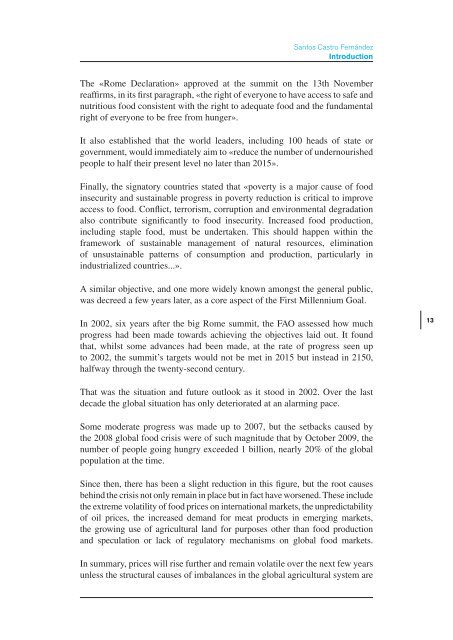Food security and global security - IEEE
Food security and global security - IEEE
Food security and global security - IEEE
- No tags were found...
You also want an ePaper? Increase the reach of your titles
YUMPU automatically turns print PDFs into web optimized ePapers that Google loves.
Santos Castro FernándezIntroductionThe «Rome Declaration» approved at the summit on the 13th Novemberreaffirms, in its first paragraph, «the right of everyone to have access to safe <strong>and</strong>nutritious food consistent with the right to adequate food <strong>and</strong> the fundamentalright of everyone to be free from hunger».It also established that the world leaders, including 100 heads of state orgovernment, would immediately aim to «reduce the number of undernourishedpeople to half their present level no later than 2015».Finally, the signatory countries stated that «poverty is a major cause of foodin<strong>security</strong> <strong>and</strong> sustainable progress in poverty reduction is critical to improveaccess to food. Conflict, terrorism, corruption <strong>and</strong> environmental degradationalso contribute significantly to food in<strong>security</strong>. Increased food production,including staple food, must be undertaken. This should happen within theframework of sustainable management of natural resources, eliminationof unsustainable patterns of consumption <strong>and</strong> production, particularly inindustrialized countries...».A similar objective, <strong>and</strong> one more widely known amongst the general public,was decreed a few years later, as a core aspect of the First Millennium Goal.In 2002, six years after the big Rome summit, the FAO assessed how muchprogress had been made towards achieving the objectives laid out. It foundthat, whilst some advances had been made, at the rate of progress seen upto 2002, the summit’s targets would not be met in 2015 but instead in 2150,halfway through the twenty-second century.13That was the situation <strong>and</strong> future outlook as it stood in 2002. Over the lastdecade the <strong>global</strong> situation has only deteriorated at an alarming pace.Some moderate progress was made up to 2007, but the setbacks caused bythe 2008 <strong>global</strong> food crisis were of such magnitude that by October 2009, thenumber of people going hungry exceeded 1 billion, nearly 20% of the <strong>global</strong>population at the time.Since then, there has been a slight reduction in this figure, but the root causesbehind the crisis not only remain in place but in fact have worsened. These includethe extreme volatility of food prices on international markets, the unpredictabilityof oil prices, the increased dem<strong>and</strong> for meat products in emerging markets,the growing use of agricultural l<strong>and</strong> for purposes other than food production<strong>and</strong> speculation or lack of regulatory mechanisms on <strong>global</strong> food markets.In summary, prices will rise further <strong>and</strong> remain volatile over the next few yearsunless the structural causes of imbalances in the <strong>global</strong> agricultural system are
















